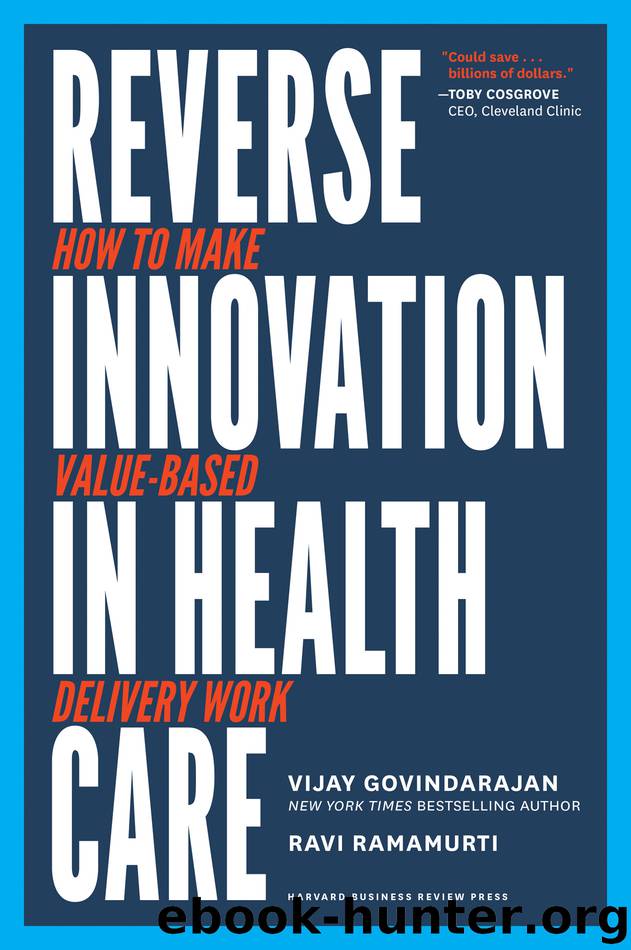Reverse Innovation in Health Care: How to Make Value-Based Delivery Work by Vijay Govindarajan Ravi Ramamurti

Author:Vijay Govindarajan, Ravi Ramamurti [Govindarajan, Vijay; Ramamurti, Ravi]
Language: eng
Format: epub
ISBN: 9781633693678
Publisher: Harvard Business Review Press
Published: 2018-07-09T16:00:00+00:00
Expanding the Network beyond Emergency Care
This hospital-saving value was magnified in 2008, when UMMC began to add specialties other than emergency care to the telehealth network. The TelEmergency network now had a modest infrastructure and a dozen participating hospitals. UMMC also had a separate store-and-forward system in place that allowed rural hospitals to send cardiology images to Jackson to be read by specialists there. Why not use all that capacity to deliver other specialty services to the rural hospitals electronically?
Expanding the service offerings would solve another problem that Henderson had noted. Many rural clinics routinely referred their patients to Jackson for specialist care—cardiology checkups, dermatology consultations, and so on. Henderson identified the clinics with the highest such referrals and paid them a visit. “We’d say, ‘Hey, a large number of patients from your town are coming to see our cardiologists,’” she remembers. “‘How about we partner and the patients stay there, and we’ll bring the cardiologist to your clinic virtually?’”
As the network grew laterally, adding clinics and hospitals in town after town, UMMC also expanded the menu of service offerings, starting with telepsychiatry in 2008. Next in were radiology, pathology, and cardiology and, in a later wave, ophthalmology, obstetrics, neonatology, dialysis, dermatology, and pulmonology. In 2011, UMMC officially launched its Center for Telehealth, which rolled the original TelEmergency program in with all the new telemedicine services.
In expanding the services, Henderson was careful not to cannibalize rural specialists’ practices. Before proposing a telelink, she would comb state records and map out where specialists were already practicing. Where there was coverage, she backed off. Where there was a gap, she’d step in.
“We’d find a region of six counties where none of them had a dermatologist,” she told us by example. “Then we’d find a couple of clinics to contract with to provide that service. That way we didn’t have pushback. We were enhancing, not taking away. I wanted to build a model of collaboration.”
As the service offerings diversified, payment arrangements evolved. Mississippi insurers still didn’t pay for telehealth consults, so the spoke hospitals continued their monthly payments to UMMC, but that fee was customized to the particular services for which the hospital or clinic contracted. While all spokes paid an “administrative fee” to cover UMMC’s technology and support costs, each also paid a “clinic fee” based on the number of specialty services and consult hours it would use, with charges calculated at fair market value. And as the network grew, the administrative share of the cost decreased, and the savings were passed on to local hospitals.
“We worked hard to get the costs and benefits right,” Henderson says. “I’m not going to say it was a rose garden. There were plenty of times I thought I would be escorted out of meetings.”
But Henderson had pulled off a kind of health-care trifecta: The community hospitals benefitted from the opportunity to perform the lab or diagnostic tests locally. Their patients benefitted because they didn’t have to travel so far to see a specialist. And the specialists in Jackson benefitted because they received a monthly take from the clinic fee.
Download
This site does not store any files on its server. We only index and link to content provided by other sites. Please contact the content providers to delete copyright contents if any and email us, we'll remove relevant links or contents immediately.
Bad Blood by John Carreyrou(6552)
Rich Dad Poor Dad by Robert T. Kiyosaki(6403)
Principles: Life and Work by Ray Dalio(6213)
Playing to Win_ How Strategy Really Works by A.G. Lafley & Roger L. Martin(5922)
Management Strategies for the Cloud Revolution: How Cloud Computing Is Transforming Business and Why You Can't Afford to Be Left Behind by Charles Babcock(4527)
The Confidence Code by Katty Kay(4187)
Thinking in Bets by Annie Duke(4153)
American Kingpin by Nick Bilton(3757)
Delivering Happiness by Tony Hsieh(3365)
Project Animal Farm: An Accidental Journey into the Secret World of Farming and the Truth About Our Food by Sonia Faruqi(3177)
The Power of Habit by Charles Duhigg(3062)
Brotopia by Emily Chang(3001)
The Tyranny of Metrics by Jerry Z. Muller(3000)
Mastering Bitcoin: Programming the Open Blockchain by Andreas M. Antonopoulos(2981)
The Marketing Plan Handbook: Develop Big-Picture Marketing Plans for Pennies on the Dollar by Robert W. Bly(2975)
I Live in the Future & Here's How It Works by Nick Bilton(2935)
The Content Trap by Bharat Anand(2860)
Building a StoryBrand by Donald Miller(2842)
Applied Empathy by Michael Ventura(2839)
